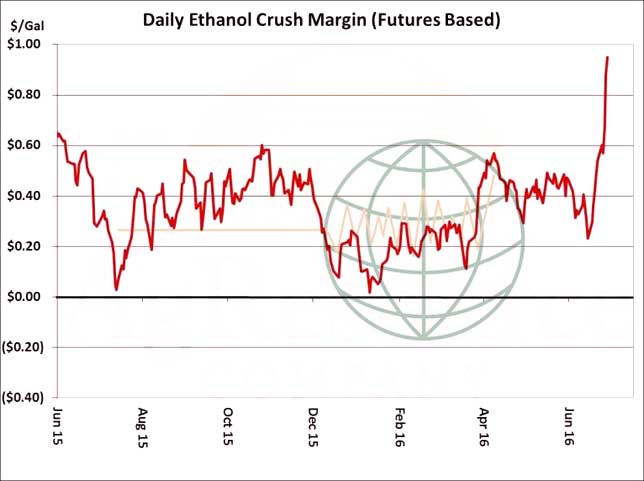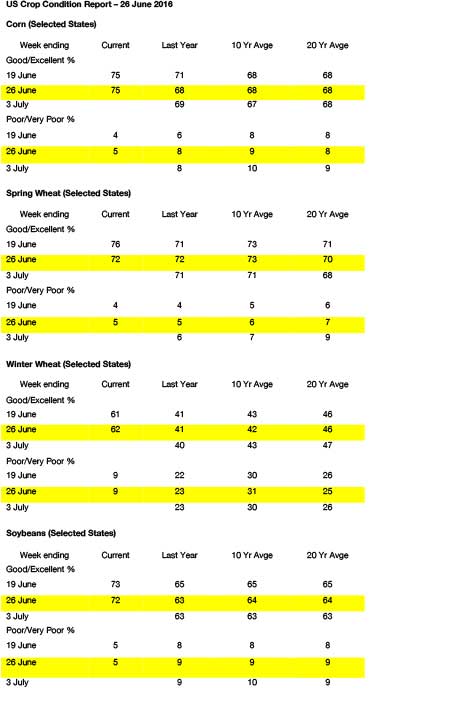- The USDA has today released its weekly export figures as detailed below:
Wheat: 645,400 mt, which is above estimates of 300,000-600,000 mt.
Corn: 1,004,600 mt, which is within estimates of 1,000,000-1,450,000 mt.
Soybeans: 1,528,000 mt, which is within estimates of 1,100,000-1,600,000 mt.
Soybean Meal: 159,700 mt, which is within estimates of 100,000-275,000 mt.
Soybean Oil: 62,400 mt, which is within estimates of 40,000-70,000 mt.
- Brussels has issued weekly wheat export certificates totalling 503,710 mt, which brings the season total to 32,94 million mt. This is 86,974 mt (0.26%) ahead of last year.
- USDA acreage and quarterly stocks data released today was reported as follows:
US all wheat area: 50.816 million acres, above estimates of 49.869, up from 49.559 last quarter and down from 54.644 year on year.
US corn area: 94.148 million acres, above estimates of 92.896, up from 93.601 last quarter and up from 87.999 year on year.
US soybean area: 83.688 million acres, below estimates of 83.834, up from 82.236 last quarter and up from 82.650 year on year.
US wheat quarterly stocks: 981 million bu, just below estimates of 982 million bu, down from 1.372 billion bu last quarter and up from 752 million bu year on year.
US corn quarterly stocks: 4.722 billion bu, above estimates of 4.528 billion bu, down from 7.808 billion bu last quarter and up from 4.453 billion bu year on year.
US soybean quarterly stocks: 870 million bu, above estimates of 829 million bu, down from 1.531 billion bu last quarter and up from 627 million bu year on year.
- The June report held a few varied surprises such as larger than expected US corn stocks, larger than expected US corn seeding, and a soybean seeding number that did not change the bullish outlook for this market. The soybean/corn ratio pushed out to an historic high of 3.1:1 and the ratio promises to rise even more in the trading days ahead. It appears that the report is bullish soybeans, neutral to bearish wheat, and bearish corn. We expect that the strong soybean market will drag the grains upwards on short covering into the weekend. US soybean futures could score new rally highs. NASS estimated that US corn area expanded to 94.1 Mil acres, up 7% from 2015, and the third largest US corn area since 1944. The US farmer did not shift acres away from corn to soybeans according to the report, US farmers continue to favour the higher yielding corn crop. With a trendline yield of 168.6 bushels/acre, the US will produce a corn crop of 14.6 billion bu. This will push US 2016/17 corn end stocks above 2,300 million bu. US soybean plantings were forecast by NASS at a record high 83.7 million acres, which is up 1% from last year with record high plantings recorded in; MI, MN, NY, ND, OH, PA, WI.
- Total principle US seeded crops expanded to 323.427 million acres, with expansion across all areas of the Central US, except the Plains and MS. Combined US corn and soybean acres rose 7.187 million acres! The biggest falls in US acres occurred in all wheat at minus 2.923 million acres and sorghum at minus 1.234 million acres. The real surprise was the rise in US hay acres at 1,690 million acres. The rise in US hay acres is likely to keep pressure on US forage prices well into mid 2017. US corn stocks at 4.722 billion bu were 269 million bu larger than last year, up 6%. Much of the corn stocks were held off farm which was up 9% from the prior year with commercial stocks up 3% at 2.25 billion bu. US farmers still have a sizeable cash corn position to sell before the new crop harvest. It is estimated that third quarter corn feed/residual is 992 million bu, which will be down 124 million bu. The US third quarter soybean residual was pegged at minus 80 million bu, double the rate of the past crop year. US June 1st soybean stocks at 870 million bu were up 243 million bu from last year. The larger stocks will help buffer the large export demand that appears forthcoming in August and September. US June 1st wheat stocks at 981 million bu were right at trade estimates and will represent 2015/16 final supplies. 4th quarter US wheat use was projected at 391 million bu or up just 1% from the year prior.
- Based upon strong export demand for US soybeans, the 2016/17 balance sheet will remain tight. We expect that November soybeans could push to new rally highs with potential to $13.00. On the other side is the oversupplied grain market with corn and wheat prices to try to follow the complex, but without adverse weather, December corn could reach $3.20-3.40 with July Chicago wheat reaching our long held downside price target of $4.00-4.25. The soybean market reconfirmed bullish price trends with US seeded acres that did not exceed 84 million. The bearish surprise was corn via both stocks/seeding with US 2016 corn plantings at their third largest level since 1944. The soy/corn ratio could rise to a record 3.5-3.7:1 as the market tries to buy additional 2017 S American soybean acres.



